
by Laura Tiu | Sep 9, 2021

A Lionfish Removal and Awareness Day festival volunteer sorts lionfish for weighing. (L. Tiu)
The northwest Florida area has been identified as having the highest concentration of invasive lionfish in the world. Lionfish pose a significant threat to our native wildlife and habitat with spearfishing the primary means of control. Lionfish tournaments are one way to increase harvest of these invaders and help keep populations down. Not only that, but lionfish are a delicious tasting fish and tournaments help supply the local seafood markets with this unique offering.
Since 2019, Destin, Florida has been the site of the Emerald Coast Open (ECO), the largest lionfish tournament in the world, hosted by Destin-Fort Walton Beach and the Florida Fish and Wildlife Commission (FWC). While the tournament was canceled in 2020, due to the pandemic, the 2021 tournament and the Lionfish Removal and Awareness Day festival returned to the Destin Harbor May 14-16 with over 145 tournament participants from around Florida, the US, and even Canada. The windy weekend facilitated some sporty conditions keeping boats and teams from maximizing their time on the water, but ultimately 2,505 lionfish were removed during the pre-tournament and 7,745 lionfish were removed during the two-day event for a total of 10,250 invasive lionfish removed. Florida Sea Grant and FWC recruited over 50 volunteers from organizations such as Reef Environmental Education Foundation, Navarre Beach Marine Science Station and Tampa Bay Watch Discovery Center to man the tournament and surrounding festival.
Lionfish hunters competed for over $48,000 in cash prizes and $25,000 in gear prizes. Florida Man, a Destin-based dive charter on the DreadKnot, won $10,000 for harvesting the most lionfish, 1,371, in 2 days. Team Bottom Time secured the largest lionfish prize of $5,000 with a 17.32 inch fish. Team Into the Clouds wrapped up the $5,000 prize for smallest lionfish with a 1.61 inch fish, the smallest lionfish caught in Emerald Coast Open History.
It is never too early to start preparing for the 2022 tournament. For more information, visit EmeraldCoastOpen.com or Facebook.com/EmeraldCoastOpen. For information about Lionfish Removal and Awareness Day, visit FWCReefRangers.com
“An Equal Opportunity Institution”

by Rick O'Connor | Aug 18, 2021
This is a famous fish. If you look back at the old tourism magazines of the early 20th century you will see a lot about tarpon fishing in Florida. As a matter of fact, some say that tarpon fishing was the beginning of the tourism industry in the state. Also known as “silver kings”, they put up a tremendous fight which anglers love, particularly on lighter tackle. It is a sport fish, not sought for food, so catch and release has been the rule for years. But those who seek them will tell you it is worth the fight even if you must release it.

Tarpon have been a popular fishing target for decades.
Photo: NOAA
Tarpon (Megalops atlantica) are large bodied, large scaled fish, with a deep blue back and silver sides. They are a large fish, reaching over 8 feet in length and up to 350 pounds. They tend to travel in schools and are often associated with other fish, such as snook2.
It has always been thought of as a “south Florida fish”. As mentioned, down there it is a popular fishing target for tourist and residents alike. Many charter captains specialize in catching the fish and they have been featured in fishing programs. But you do not hear about such things in the Florida panhandle. Hoese and Moore1, as well as the Florida Museum of Natural History2 both indicate that they are in fact in the Florida panhandle. As a matter of fact, this fish has few barriers and has the distribution of the classic “Carolina fish” group. That includes the entire eastern seaboard of the United States, the entire Gulf of Mexico, and the Caribbean1. The Florida Museum of Natural History indicates they are found on the opposite shores of the Atlantic Ocean and may have made their way through the Panama Canal to the Pacific shores of the canal. Within this range they are known to enter freshwater rivers. They seem to have few biogeographic barriers.
I grew up in the panhandle and remember hearing about them swimming in our area when I was younger. Fishermen said they would throw all sorts of bait at them. Artificial lures, live bait, cut bait, you name it – they tossed it… the tarpon never would take it. Catching one here was almost impossible. The flats fishing charter trips for tarpon in south Florida would not happen here. I remember once diving in Pensacola Bay near Ft. Pickens. We were looking for an old Volkswagen beetle that had been sunk years ago when at one point the water became very dark – almost like storm clouds had rolled in. When my buddy and I both looked up we saw a school of very large fish swimming above us. We were not sure what they were at first but as we slowly ascended, we realized they were tarpon. It was pretty amazing.
An interesting side note here. In 2020 tarpon were once again seen swimming around the Pensacola area but this time they WERE taking bait. There were several reports of tarpon caught off the Pensacola Fishing Pier and inside the bay. Why change over all this time? I am not sure.

The ladyfish (or skipjack) is the smaller cousin of the tarpon, but puts up a good fight as well.
Photo: University of Southern Mississippi
Tarpon belong to the family Elopidae which also includes another local fish known as the “ladyfish” or “skipjack” (Elops saurus). This is a much smaller fish reaching about 3 feet (and that would be a large ladyfish). The scales of this family member are much smaller, but the fight on hook and line is just as large. The characteristic that places these two fish into the same family (and these are the only two in this family) is the hard bony gular plate found between the right and left side of the lower jaw (in the “throat” area).
Like tarpon, it is not prized as a food fish but more of a game fish. It has the classic wide distribution of the “Carolina fish group” – the eastern seaboard of the United States, the Gulf of Mexico, down to Brazil. Like the tarpon, it is found in brackish conditions but is not mentioned in freshwater. Again, few biogeographic barriers for this fish.
Both members of this family provide anglers young and old with a lot of enjoyment.
1 Hoese, H.D., R.H. Moore. 1977. Fishes of the Gulf of Mexico; Texas, Louisiana, and Adjacent Waters. Texas A&M Press, College Station TX. Pp. 327.
2 Discover Fishes. Tarpon. Florida Museum of Natural History. https://www.floridamuseum.ufl.edu/discover-fish/species-profiles/megalops-atlanticus/.
3 Discover Fishes. Ladyfish. Florida Museum of Natural History. https://www.floridamuseum.ufl.edu/discover-fish/species-profiles/elops-saurus/.
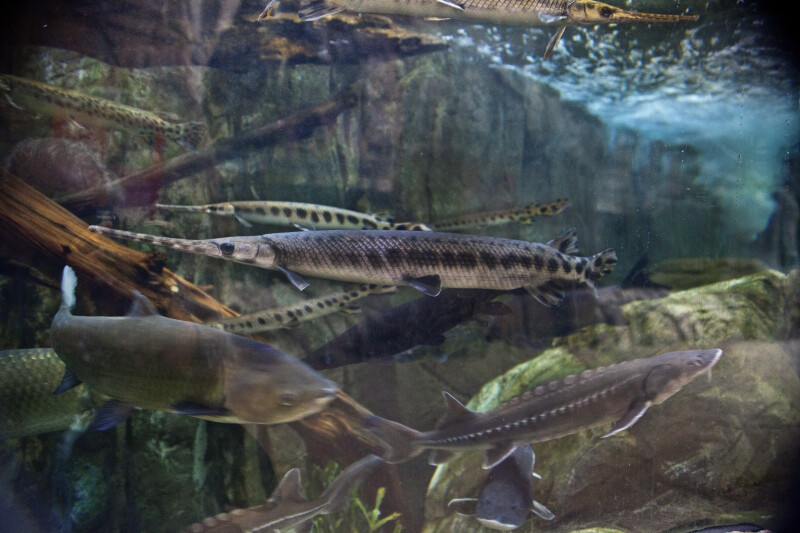
by Rick O'Connor | Aug 8, 2021
Like the ancient sturgeon, this is one strange prehistoric looking group of fish. I’ll say group of fish because there is more than one kind. For many, all gars are alligator gars. There is an alligator gar but there are others. Actually, the longnose gar may be seen more often than the alligator gar, but many do not know there is more than one kind.
Gars are freshwater fish, but several species have a high tolerance for saltwater. The alligator gar (Artactosteus spatula) has been reported from the Gulf of Mexico1. They are elongated, slow moving fish with extended snouts full of sharp teeth – very intimidating to look at. But swimming with gars in springs and rivers, I have found them to be oblivious to me. Snag one in a net however, and they will turn quickly and could do serious harm. While fishing my grandson had one come after his bait once and that was pretty exciting, but it is rare to catch them on hook and line. Many who fish for them do so with bow and arrow. Their skin is covered with tough ganoid scales. You really can’t scale them; you have to skin them.

Alligator Gar from the Escambia River.
Photo: North Escambia.com
In the book Fishes of the Gulf of Mexico, by Hoese and Moore, they list four species of gar in the northern Gulf. As the name suggests, the longnose gar (Lepisosteus osseus) has a long slender snout and has spots on the body. It is the one most often seen by people visiting our springs, rivers, and the one most often seen in our estuaries. It can reach a length of five feet3.
The famous alligator gar (Artactosteus spatula) has a shorter snout and spots are usually lacking. If they do have them, the are usually on the fins. This is a big boy – reaching lengths of nine feet and up to 100 pounds2. They are common in coastal estuaries and even the Gulf, though not encountered very often.
The spotted gar (L. oculatus) also has a short snout but has spots all over its body. It prefers the rivers and will enter estuaries only where the salinities are low. It is smaller at four feet4.
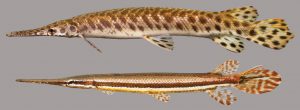
Spotted Gar.
Photo: University of Florida
The last panhandle gar is the shortnose gar (L. platostomus). This species too prefers rivers and may enter low salinity bays. It has a short snout and lacks spots.
There is a Florida gar (L. platyrhincus) not found in the panhandle but exists along the central and south Florida gulf coast. It seems to have replaced the spotted gar in this location5.
The biogeography of this group of fish is interesting in that it is an ancient like the sturgeon, it existed during a time period when much of Florida would have been underwater. The general range of gars is the entire eastern United States. They prefer slow moving rivers, or backwaters of faster rivers, and are common in springs. As mentioned, a few species will venture into saltwater and can be found around the Gulf of Mexico. But with several species there has obviously been some speciation over time.
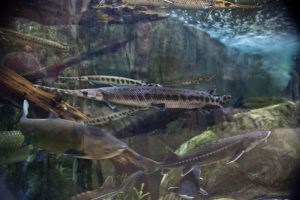
The common longnose gar.
Photo: University of South Florida.
The longnose gars have one of the widest distributions within the group. They are found in most river systems across the eastern United States and all of Florida. It seems to have few barriers including saltwater.
Alligator gars have a similar distribution but seem to be restricted from the peninsula part of Florida. The Florida rivers where they are found are all in the panhandle and are all alluvial rivers – muddy and not tannic like the Suwannee. This could be due to required food that prefer alluvial rivers, pH (pH is lower in the tannic rivers), or something else. Though they did not disperse into central and south Florida, they did extend their range westward down into Mexico. And, as mentioned, have been reported in the open Gulf of Mexico.
Spotted gars follow a similar distribution to the alligator gar. Much of the Mississippi River basin, Florida panhandle, and west to Texas – but they are not found in peninsular Florida. Pre-dating the emergence of peninsular Florida from the sea, there was some barrier that prevented them from dispersing south when the landmass did appear.
A different species appeared in peninsular Florida along with the longnose gar – the Florida gar. It is found in central and south Florida and has dispersed a little north along the Atlantic coast to Georgia.
This is an interesting group of ancient fish. Some are commercially harvested and have suffered from human alterations of river systems. They are amazing to see.
1 Hoese, H.D., R.H. Moore. 1977. Fishes of the Gulf of Mexico; Texas, Louisiana, and Adjacent Waters. Texas A&M Press, College Station TX. Pp. 327.
2 Discover Fishes. Florida Museum of Natural History. Alligator Gar. https://www.floridamuseum.ufl.edu/discover-fish/florida-fishes-gallery/alligator-gar/.
3 Discover Fishes. Florida Museum of Natural History. Longnose Gar. https://www.floridamuseum.ufl.edu/discover-fish/florida-fishes-gallery/longnose-gar/.
4 Discover Fishes. Florida Museum of Natural History. Spotted Gar. https://www.floridamuseum.ufl.edu/discover-fish/florida-fishes-gallery/spotted-gar/.
5 Discover Fishes. Florida Museum of Natural History. Florida Gar. https://www.floridamuseum.ufl.edu/discover-fish/florida-fishes-gallery/florida-gar/.
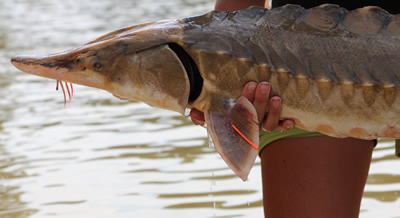
by Rick O'Connor | Jul 9, 2021
This is one strange, primitive, dinosaur-looking fish. They have large scutes embedded in their skin that give them an armored look. They are big – reaching 14 feet in length and 800 pounds (though the Gulf sturgeon does not reach the large size of their cousin the Atlantic sturgeon). They resemble sharks with their heterocercal caudal fin and possess long whiskers (barbels) suggesting a benthic mode of feeding.

Sturgeon are large fish. The barbels (whiskers) are for finding prey buried in the sediment. Notice the raised ganoid scales of this ancient creature.
Photo: U.S. Fish and Wildlife Service.
Panhandle residents know them from their impressive leaps as they head upriver for spawning in the spring. The loud splash from one of these leaps can be heard for a long distance and is a concern for boaters who may be zipping up and down one of the local rivers on a jet sky, or even a bass boat. When in college, we asked one of the professors – “why do mullet jump?”. He paused for a second and responded – “for the same reason manta rays jump”. There was another longer pause. Understanding what was going on we took the bait and asked – “okay… why do manta rays jump?” – “we don’t know”. However, that was in 1980 and a lot has been learned since. We know that not only do mullet and mantas leap, but baleen whales and sturgeon do as well. It is believed that baleen whales leap to communicate during the breeding season. Since sturgeon breed in panhandle rivers, it is believed that this is the reason they may do so. Scientists have also found it helps adjust their swim bladders with internal gas making them more buoyant in the water.
Like salmon, sturgeon swim up rivers to breed and spawn in the spring. Fertilization is external and the gray-black eggs are laid on the substrate at the bottom. The newborn and adults spend the remaining spring in the rivers, and the adults do not feed at this time. In summer all head for the estuaries where the adults begin feeding with a vengeance. They feed on a variety of benthic invertebrates and prefer sections of the bay that are well oxygenated. Sturgeon spend the summer and much of the fall in the bays until the temperatures begins to drop at which time they head into the open Gulf of Mexico. The spring, they find their breeding rivers and the reproductive cycle begins again. This is a long-lived fish, reaching up to 50 years in age.
As far as the biogeography of this species, it is an interesting one. They have been around for about 200 million years. This was about the time the whole “Pangea” movement was going on – Florida did not look like Florida then. There was an opening between what is now the southeastern United States and the Florida peninsula. The water moving through this was called the Georgia Seaway or the Suwannee Channel. This allowed marine species to easily move from the Atlantic to the Gulf of Mexico. It was believed the current in this seaway was significant enough to keep silt and clays from reaching what would be become peninsula Florida, which was probably a submerged region of islands at the time.
During those times the Atlantic sturgeon (Acipenser oxyrinchus) inhabited this region, using southeast rivers for breeding. About 25 million years ago global land mass changes began a period of ice formation that encouraged sea level to drop and the peninsula portion of Florida was exposed – the Florida people know today. However, this new peninsula isolated populations of sturgeon (and other fish at that time) from reaching each other. As time moved on, different genetic changes occurred in both populations to produce offspring that varied from each other. These external morphological changes were enough to let you know they were different, but genetically they are close enough to still breed. In these situations, they have deemed “subspecies” of each other. The Atlantic sturgeon (Acipenser oxyrinchus oxyrinchus) and the Gulf sturgeon (Acipenser oxyrinchus desotoi). It is the Gulf sturgeon we find along the panhandle. This process of producing new subspecies and species due to population isolation over time is called speciation.
Another interesting trend is the original range of the Gulf sturgeon was from the Texas/Louisiana border to about Tampa Bay. This suggest that the fish took advantage of numerous rivers for breeding but there was a barrier as you reach the tropics. Whether that barrier was climatic (temperature) biological (food source) or something else I am not sure. With the high concentration of sturgeon in the panhandle you might think they require the alluvial rivers of this region. But sturgeon are as common in tannic rivers, such as the Suwannee and Yellow Rivers, as they are in those alluvial ones, such as the Escambia and Apalachicola.
Today, their range is even smaller. They are now found only in the rivers between Louisiana/Mississippi border to the Suwannee River. This range reduction is probably due to habitat alteration (much of it human induced – such as dams) and overharvesting (the eggs of the sturgeon are used for caviar). Today all species and subspecies of sturgeon are protected by the endangered species act.
Because this is an ancient fish, the biogeographic story of the sturgeon is an interesting one and shows how speciation occurs over time with all life. They are really cool fish and, if you have not seen one leap yet, I hope you get to. It is pretty amazing.
References
Florida’s Geologic History, University of Florida IFAS, https://edis.ifas.ufl.edu/publication/UW208.
NOAA Species Directory, Gulf Sturgeon, https://www.fisheries.noaa.gov/species/gulf-sturgeon.
NOAA Species Directory, Atlantic Sturgeon, https://www.fisheries.noaa.gov/species/atlantic-sturgeon.
Sturgeon, Florida Fish and Wildlife Conservation Commission, https://myfwc.com/conservation/you-conserve/wildlife/sturgeon/#:~:text=When%20the%20ambient%20pressure%20changes,to%20communicate%20with%20other%20sturgeon..
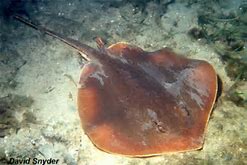
by Rick O'Connor | Jun 18, 2021
In our continuing series on the biogeographic distribution of island vertebrates, this week we look at a creature that, for some, is as scary as sharks – the rays. The term stingray conjures up stinging barbs and painful encounters, and these have happened, but rays are easily scared away by our activity. Occasionally people will step on one and the venomous spine is used to make you move your foot. You can avoid this by shuffling your feet when moving across the sand. Rays detect the pressure and move before you reach them. Again, negative encounters with rays are not common.

The Atlantic Stingray is one of the common members of the ray group who does possess a venomous spine.
Photo: Florida Museum of Natural History
There are 18 species of rays (from 9 families) found in our area. An interesting note, only eight of those possess a barb for stinging, and five are from the family Dasyatidae (the stingrays). Others that have barbs include the butterfly ray, cownose ray, and the eagle ray.
Rays are related to sharks but differ in that (a) the pectoral fin begins before the gills slits, and (b) the gill slits are on the underneath of the body – not on the side as found in sharks. Shark distribution seems to be controlled by water temperature. We see this with ray distribution as well, but interestingly the skates seem to be restricted to the Gulf of Mexico. Some are found almost exclusively in the east or west side of the Gulf.
Skates resemble stingrays but lack the venomous barb. They will usually have small thorns on their bodies and lay their developing embryos in a leathery egg case folks call “mermaid’s purse” when they wash ashore. There are four species found in the Gulf, but the spreadfin skate is ONLY found in the Gulf of Mexico and is not found along the Florida peninsula. The clearnose skate, which can be found all along Florida and the eastern seaboard of the U.S., is absent from western Gulf. It is interesting to try and understand why. What barrier keeps these two skates from colonizing the entire Gulf?
There is a large plume of muddy freshwater that expands from the Mississippi River into the Gulf off Louisiana. This plume could be a barrier for coastal species trying to expand their range. However, the spreadfin skate is reported to be an outer continental shelf species and may not be influenced by this lower salinity water. So, what is their story?
And why are these not found in the Caribbean? In the Caribbean you do enter tropical waters where coral reefs become more common. There is certainly a species shift when you reach this zone and it could be the food needed by these skates is not found here – a biological barrier. Many find these biogeographic situations interesting.
There are 12 species that have the typical “Carolina marine fish” distribution, which means they are found throughout the Gulf up the eastern seaboard to Massachusetts and south to Brazil. Two, the Atlantic torpedo ray and the roughtail stingray, expand their range farther into Canada. As a matter of fact, the roughtail stingray prefers colder waters.
Torpedo rays are an interesting group. This family of fish includes two species here in the Gulf, the Atlantic torpedo ray and the lesser electric ray. Yep… these two have special muscle cells that can deliver an electric shock. It is believed this electric current can detect and stun prey as well as repel predators. The voltage is not dangerous but will get your attention.
Three of those “Carolina marine species,” the guitarfish, the lesser electric ray, and the yellow stingray, do not reach Massachusetts. Their distribution ends at North Carolina. You would have to guess water temperature as a barrier here. The warm Gulf stream begins heading east across the Atlantic Ocean off Cape Hatteras towards Europe. They could follow this current to Bermuda, but they have not been reported there. This could be due to depth (pressure), being benthic fish, or food barriers.
There is one family that is tropical, the sawfish. These bizarre dinosaur looking creatures were once common in the estuaries of the Gulf region. They are now rare and protected.
One species of stingray, the Atlantic stingray has been found in the lower reaches of Louisiana rivers. Like bull sharks, salinity may not be a barrier for them.
And then we have our “world travelers”. The manta and eagle rays are found across the globe in tropical waters, and eagle rays are common in temperate parts of the world.
The distribution of our rays is not as universal as sharks. The skates in particular have an interesting distribution pattern. Pensacola lies right at the boundary of the eastern and western Gulf of Mexico, so we find both geographic groups here. Though they may scare many people, rays are fascinating creatures and cool to see.
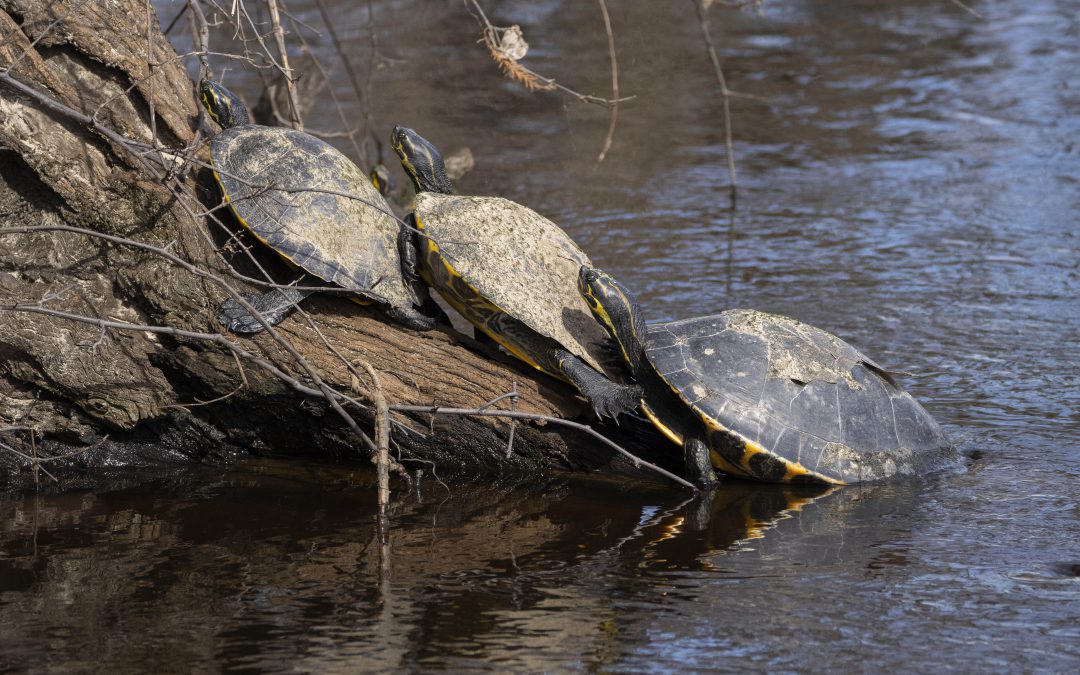
by Erik Lovestrand | Jun 3, 2021
Identifying North Florida river turtles can be quite challenging, given the fact that several species are collectively referred to as “streak-ed heads” by many people. Although you will not find this term in the scientific naming conventions, it is actually an apt description for many turtles in the Southeast that have dark skin with thin, yellow pinstripes on their head and neck. North Florida has at least half a dozen species that fall into this general grouping. They include the Suwannee cooter, river cooter, Florida cooter, chicken turtle, yellow-bellied slider and a couple of map turtles. We even have a disjunct population of Florida red-bellied turtles on the Apalachicola River that are isolated from the main group, which is restricted to peninsular Florida and extreme Southeastern Georgia. Overall, we have about 25 species of turtles in Florida.
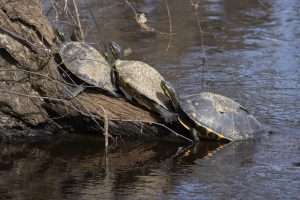
Suwannee cooters at Lafayette Blue Springs, Lafayette County, Florida, 2021.
FWC Photo by Andy Wraithmell
As you might guess, the key to accurate river turtle identification lies in the details and the details can be tough to see. Most basking turtles tend to tumble off their logs into the water long before you are close enough to scrutinize their features. However, a few tips and tricks may improve your chances when going afield. A good pair of binoculars and a reptile field guide are must-haves. You need to be able to see if the yellow on the side of the head is a wide splash (as on the yellow-bellied slider), or a series of thin lines (as on various cooters). If the top shell (carapace) is very dark and the bottom shell (plastron) shows orange color, you might have a red-belly or Suwannee cooter (higher dome on red-belly, relatively). Two of our native species have what are referred to as “striped breeches”. When viewed from the rear, the stripes on the hind legs are vertically oriented on the yellow-bellied slider and the Florida chicken turtle. The chicken turtle is distinguished by a relatively narrower head and a wide, yellow stripe on the front legs. Separating the various cooter species gets a little trickier. You need to use characteristics like the pattern on the plastron, the occurrence of “hairpin-shaped” stripes on the head, or the pattern of lines on particular carapace scutes.
So how do you get those clues in the wild? A good telephoto lens may work if you are fortunate enough to own one. This will give you the opportunity to study detailed features at your leisure. Otherwise, you may not be able to identify a turtle to the species level. Getting close to a wary turtle is not easy. However, on busy stretches of our waterways, where wildlife are desensitized to people and boats, turtles generally have a wider comfort zone. Especially if you are in a canoe or kayak and minimize your movement and sound as you glide in for a better view. Lastly, go looking on a bright sunny day and your opportunities will vastly increase as turtles climb out of the water onto logs to soak up some of that good old Florida sunshine. One species that you should have no trouble naming when encountered, is the softshell turtle. Softshells will extend their extremely long neck upward when basking and their flexible, smooth shell will appear flattened in profile. They are the only turtles here with a tubular snout. Never try to pick one up if encountered crossing a road, as they do not hesitate to bite and have extremely sharp and powerful jaws. In general, even if you are confident in not getting nailed, you will probably be wrong, given the extremely long neck that can reach more than halfway back on the shell. Also, all of our water turtles have very sharp claws on their hind feet and will manage to get in a few good rakes before you decide to put them down, or worse yet, drop them on the pavement and injure them.
Now, when you think you are getting good at basking turtle identification, start looking for some of our less obvious, smaller species. These include stinkpots, musk turtles, mud turtles, map turtles and box turtles; all very cool critters. But if you think you want to pick up one of the cute little buggers, beware. Most of the little ones will bite too…hard! Believe me. Happy “turtling!”













